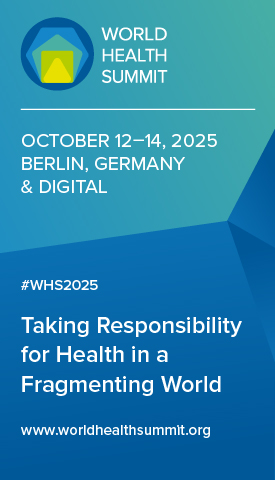Integrating global health governance for a fragmented world
As interconnected crises loom ahead that threaten our physical, mental and social well-being, the world urgently needs global health governance to replace our existing fragmented systems
The outbreak of the deadly Covid-19 pandemic in 2020 catalysed a proliferation of innovation in health practice, policy and governance. But almost four years later, serious questions remain about how integrated and impactful the many institutional innovations at the global, regional and country levels have been.
Covid-19 and its ongoing offspring from new variants dramatically showed that the health of our planet and its living things is a highly integrated whole. It also showed that our ways of protecting and promoting their health and well-being remain fragmented, and consequently often fail to meet the growing global need.
The midsummer arrival in 2023 of the unprecedented heat and extreme weather events around the world further showed that our planet is a single integrated ecosystem, on which its people, animals and plants directly depend to stay alive and thrive. Our failure to protect the health of our planet is harming the physical, mental and social well-being of its eight billion human inhabitants and their descendants for generations to come.
The death and damage are compounded by the simultaneous eruption of several other, interconnected crises that threaten to overwhelm us: armed conflict between and within states, and resulting energy and food insecurity, inflation, debt crises and development lags. As a result, progress towards reaching the United Nations’ 17 Sustainable Development Goals is stalling as we pass the halfway mark to deliver them by 2030.
The world thus urgently needs global health governance to replace the fragmentation of an incomplete set of single silos with integration based on synergies among all its components and coherence as a comprehensive whole.
The World Health Organization
At the centre of the global health architecture stands the World Health Organization. It alone has the legal power and political responsibility “to act as the directing and coordinating authority on international health work”.
It admirably defines health as “a state of complete physical, mental and social well-being and not merely the absence of disease or infirmity”. With full inclusiveness it affirms “the health of all peoples is fundamental to the attainment of peace and security and is dependent on the fullest co-operation of individuals
and States”.
The WHO and its governing body, the annual ministerial-level World Health Assembly, have initiated, overseen or contributed to many of the institutional and legal innovations catalysed by the Covid-19 crisis. These include efforts to revise the International Healthy Regulations and to create a fund for pandemic preparedness and response, COVAX and its Accelerator, and the WHO Hub for Pandemic and Epidemic Intelligence in Berlin. The crisis also led WHA member states to agree to increase to 50% the share of their WHO financing they give as assured, assessed contributions, rather than in voluntary, discretionary form.
Yet the WHO’s budget remains only the size of that of a large hospital in a major city, while its responsibilities are global and far greater. And there is doubt that member states will raise their share of assessed contributions. Their failure here would increase the fragmentation within the WHO, with each member voluntarily providing what and when it wants, to address the particular disease or instrument it prefers. While this can produce platforms to support other health-inducing activities, as the major funding to combat HIV/AIDS shows, it tends to favour responses to acute outbreak events, rather than action to prevent them, or to strengthen the social, economic and ecological determinants of health.
The G7
Integration requires a whole-of-government approach and thus active global governance by heads of state and government. They alone have the domestic political authority, comprehensive vision and responsibility to act on all the major components and causes of health. A major contribution has thus come from the annual summits of the G7 major democratic powers, formed in 1975 and acting on health since 1979. G7 summits have given health up to 72% of their outcome documents, made 687 collective, precise, future-oriented, politically binding decisions, and complied with them at an average of 78%.
This year, the G7 summit in Hiroshima on 19–21 May produced 34 health commitments. The health ministers’ meeting, in Nagasaki on 13–14 May, focused on strengthening global pandemic prevention, preparedness and response (referred to as PPPR), universal health coverage and health innovation, emphasising antimicrobial resistance and a One Health approach.
Together G7 members possess a predominance of the global capabilities required for effective global health governance, notably in finance, scientific capacity and the intellectual property for the leading vaccines and pharmaceuticals. Its global health governance has made major contributions, notably by joining with the UN in 2000–2001 to launch the Global Fund against HIV/AIDS, Tuberculosis and Malaria.
Yet the G7 has done little on mental health, dementia and the other health needs of the ageing populations in Japan and Italy, and beyond in Korea, China and elsewhere. Moreover, the G7 has no members from the Global South, where the greatest burden of disease now lies, where more capacity is needed most and where many cost-effective innovations exist. As leaders of often inward-looking democratic countries, G7 governors are constrained by what their voting publics want for themselves at home. Their ability to provide genuinely global health governance depends critically on how they can inspire, initiate, join or support more inclusive summit forums.
The G20
The G20’s systemically significant states are one such forum. Its leaders came together in 2008 to address the American-turned-global financial crisis erupting then. With an equal number of members from developed and developing countries, it contains 85% of the world’s economy and two-thirds of its population. It thus has the capacity to produce effective global health governance for all.
Its direct global health governance began in 2014, in response to the deadly Ebola outbreak in Africa. From then to 2022, G20 summits devoted 10% of their attention to health in their outcome documents, produced 141 commitments and complied with them at an average of 70%.
On 9–10 September 2023, G20 leaders in New Delhi produced 25 health commitments, second only to their 47 development ones.
G20 health ministers’ meetings began in 2017 in Berlin, which made 51 commitments. They culminated in August 2023 in Gandhinagar, India, where they made 28 commitments.
But the leaders’ 25 health commitments at New Delhi represented only 10% of their 242 commitments, even though Covid-19 infections and deaths had started to rise again. Unlike 2021, when Italy hosted the G20, the special G20 summit India as host has added for November 2023 will focus on development, not health. The G20 remains largely a responsive rather than a proactive, preventive body – except regarding universal health coverage and antimicrobial resistance – and is subject to the all-too-familiar cycle of panic then neglect.
The United Nations
Attention thus shifts to the fully inclusive UN and its General Assembly in New York, where all the world’s needs can be addressed.
The UN Charter in 1945, although focused on peace and security, included health as an integral part. Article 13 empowers the General Assembly to “initiate studies and make recommendations for the purpose of … promoting international co-operation in the economic, social, cultural, educational, and health fields”.
In 1996, the UN created UNAIDS to draw on the resources and actions of 11 UN system organisations, covering refugees, children, food security, population, drugs and crime, gender equality, science, education, culture, development and, of course, the WHO, for an integrated response to the HIV/AIDS pandemic.
However, after 1945, UN summits started only in 1990. Since then, its summit-level high level meetings have proliferated, including those devoted to health. In September 2023 it had four – on PPPR, universal health coverage, tuberculosis and the SDGs, whose third goal is on health.
However, while these UN health summits add value, the leaders of most UN members and especially those of the major powers seldom attend. And members’ compliance with their UN commitments is often very low.
Regional institutional integration
This underscores the importance of advances at the regional level. Here the European Union, long a leader, has created the Pan-European Commission on Health and Sustainable Development and taken other measures to integrate health and the economy and foster a ‘well-being society’ for all.
In February 2022 the African Union Assembly of Heads of State and Government made the Africa Centres for Disease Control and Prevention an autonomous health body, to confront Africa’s broad array of infectious disease outbreak events and its rising burden of non-communicable diseases. Africa CDC is now proposing a New Deal to implement a ‘New Public Health Order’, fully integrated with the AU’s Agenda 2063 and the SDGs.
Country-level contributions
At the country level, institutional integration is advancing too. The US State Department has created the Bureau of Global Health, to assemble the assets of the whole department and make global health security a key feature of US national security policy. The bureau also integrates the major resources of the President’s Emergency Fund for AIDS Relief and seeks partnerships with other countries and international institutions.
Lebanon’s Ministry of Health is implementing its comprehensive five-year National Health Strategy: Vision 2030 to integrate responses to immediate and longer-term challenges. Its Sustainable Energy Strategy for the Healthcare Sector seeks to transform the production and use of green energy, in ways that support the SDGs and the decisions of successive UN climate change conferences.
Remaining challenges
Yet there is still much to do. The first major challenge is to mobilise much more public and private finance for health and its supporting social determinants. The second is to strengthen the badly overburdened global health workforce in all its components. The third is to share technology and build manufacturing and innovation capacity throughout the developing world. And the fourth is to fully integrate health in all its dimensions into the response to climate change, which is now an existential threat for all.












